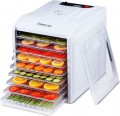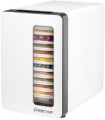Drying levels
The number of separate trays on which food can be placed during drying.
The design of the trays in food dryers can vary. Typically, they consist of separate closed compartments, but another option is a common chamber with shelves (refer to the "Location of the fan (heater)" section for more information). Regardless of the specific design, the trays are positioned vertically, with multiple trays or "floors" in modern food dehydrators. The most modest option is actually
3 trays;
4 trays — also quite a small number;
5-tray dehydrators are the most popular; noticeably less common models with
6 trays or
8 trays; and in individual devices
9 or more trays can be provided (12, and sometimes 20).
Using multiple trays or "floors" in a food dehydrators ffers several advantages. It allows for increased capacity while maintaining a compact width and depth for the entire device. The more tiers there are, the smaller the area of each individual tray becomes, enabling a smaller overall width and depth of the dehydrator. This is particularly beneficial when space is limited on a table or surface, but there is ample vertical space available. Additionally, having multiple trays allows for simultaneous drying of different types of products with varying drying times. By using ce
...rtain techniques, individual compartments and shelves can be removed without having to turn off the device. However, it's important to note that increasing the number of levels in the device affects its height and cost, reduces the capacity of each individual tray, and necessitates the use of more powerful fans to ensure even heat distribution.
It's important to note that the presence of numerous trays does not necessarily indicate a powerful or spacious food dehydrator. This design can be found in compact models as well. Devices with 3-4 tiers often do not significantly differ in capacity, although there may be exceptions to this.
At the same time, there are also models whose equipment with trays significantly exceeds the number of drying levels. But our paragraph indicates how many levels (trays) can be used simultaneously when drying.Tray size
Horizontal dimensions of one dryer tray.
For round models, this paragraph usually indicates the diameter (for example, “Ø250”), for other cases — the length and width. Anyway, the information about the size allows you to estimate the total area and, accordingly, the capacity of the device. At the same time, note that a larger size affects the dimensions and weight of the structure, and also requires more heating power (ceteris paribus).
Tray height
The size of one tray of the dryer in height. In models where, instead of separate trays, a common working chamber with removable shelves is provided, the distance between two adjacent shelves is indicated.
This size primarily determines the thickness of individual pieces of vegetables, fruits, etc., which can be placed in the device. At the same time, note that the contents should not fill the tray tightly — there should be at least a couple of millimetres of space between the products and the “ceiling”. Also note that in some models, two height values can be indicated in this paragraph — for example, “15 — 25 mm”. This means that the size of the trays can be changed, adjusting them to the specifics of the situation; usually it is a choice between two standard heights (in our example — 15 mm and 25 mm).
Total capacity
The total volume of all dryer trays. The larger the volume, the more products can be loaded into the device at a time. For modern dryers, a capacity of
up to 10 L is considered relatively small,
from 11 to 15 L — medium,
from 16 to 20 L — high, and the largest models can hold
more than 20 L.
Note that if you plan to dry several different types of fruits or vegetables at the same time, it is worth considering not only the total volume of the dryer, but also the number of trays (see above).
Power consumption
Rated power consumed by the dryer during operation.
This parameter is usually selected by manufacturers depending on the volume of the dryer: the larger the device, the more power is needed to effectively heat the working chamber. At the same time, models with the same volume may differ in power consumption. In such cases, it is worth considering that a higher power reduces the heating time, but affects the price of the device.
Tray for marshmallow
Availability
of a tray for a marshmallow in a set of delivery of the dryer.
Such a device differs from ordinary trays in the design of the bottom — it is solid, without openings. This is due to the fact that the raw material for the preparation of marshmallows is fruit puree, which simply would not have stayed on the classic grating bottom. Most often, there is only one tray for marshmallows, however, in some models it may be possible to purchase additional trays of this type.
We emphasize that it is undesirable to use such accessories for more traditional ingredients (pieces of vegetables, fruits, etc.): in some cases this reduces the drying efficiency, in others it can lead to damage to the contents.
Mesh for herbs and spices
A mesh for herbs and spices is included in the delivery set of the food dehydrator.
These meshes are characterized by a finely porous structure to prevent herbs and spices from falling through the mesh holes. They are made of silicone or stainless steel, and more rarely of bamboo. There are also variants with non-stick coating, which prevents food from sticking to the surface of the mesh.
Temperature range
The temperature range that the dryer can provide in the working chamber.
The simplest models provide only one operating temperature option, usually from 50 °C to 60 °C. More advanced devices equipped with thermostats (see above) and can have a wide range of adjustment — this is very useful, because different temperature regimes are recommended for different products. To assess the general capabilities of a particular dryer, you can use the following table of temperatures recommended for drying:
— 35...40 °C — plant stems, greens;
— 40...45 °C — bread;
— 38...42 °C (in some cases up to 45 °C) — yoghurt;
— 50...55 °C — vegetables;
— 55...60 °C — fruits;
— 65...75 °C — meat, fish.
We emphasize that these are the most general, conditional data. The specific temperature may differ from the recommended one — depending on the thickness of the slices, the specific type of food, the desired result, etc. Detailed recommendations on this matter can be found in special sources.
Control
The control panel of a fruit dehydrators.
— Control knob.
Mechanical control is carried out using rotary knobs and switches. Most parameters in such devices are set and controlled manually. In this case, the control elements are connected to the working parts of the dryer directly, without additional electronic circuits. This option is simple, reliable and low cost; however, it is only suitable for the most basic functions, but dehydrators for fruits, vegetables and mushrooms usually do not require more. But the obvious disadvantage of mechanical control is low accuracy: for example, a mechanical timer most often gives an error of a couple of minutes, which in some cases can be critical.
–
Push-button. Push-button control is based on electronic circuits. Such systems are more accurate than mechanical ones (for example, the timer in such dryers can usually be set with an accuracy of several seconds), and more options and modes are provided. On the other hand, such control is more complex and more expensive than mechanical control.
–
Touch. A type of
electronic control with touch switches. Compared to push-button models, it provides a high level of comfort in operation, and looks more modern and aesthetically pleasing. Touch control is found mainly in top models of dehydrators.

